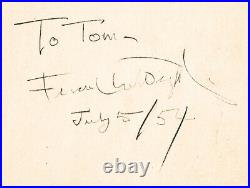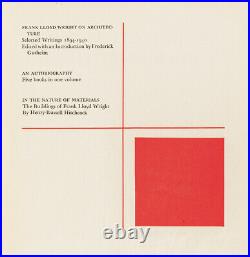



1943 FRANK LLOYD WRIGHT Signed 1st Edition Frank Lloyd Wright: An Autobiography. 1943 First Edition Frank Lloyd Wright Signed & Dated “Frank Lloyd Wright: An Autobiography”. Famous American Architect, often considered the Greatest U. Architect of all time, his greatest legacy is “Organic Architecture, ” or the idea that buildings harmonize both with their inhabitants and with their environment, who designed the Guggenheim Museum (1956-59), among many other treasured buildings. First Edition, 1943, Book “Frank Lloyd Wright: An Autobiography” Signed, Frank L. Wright” measuring 8.75″ x 8.5, Choice Very Fine. The inscription, clearly written in dark pencil on the front flyleaf reads: To Tom – Frank L. Wright – July 5 / 54. ” Published by Duell, Sloan and Pearce, New York, contains 561 pages, and has a subtitle: “Five Books in One Volume. A single full page photograph appears in the book, before the last page, showing Wright surrounded by 15 of his architecture students. There is light wear on the corners and edges of the covers, and very light toning to flyleaf and outside page edges. Otherwise this book and the Signed autograph are in excellent condition. This is the First Complete Edition of this historic and Signed book, with an entire section “Form” not in the 1932 Longman’s edition, thus a true First Edition. Printed, NY: Duell, Sloan & Pearce, 1943, it is 1st edition thus, brick cloth, with the correct 561 pages complete. Wright became the chief practitioner of the Prairie School, building about 50 Prairie houses from 1900 to 1910. Early nonresidential buildings include the forward-looking Larkin Building in Buffalo, N. (1904; destroyed 1950), and Unity Temple in Oak Park, Ill. In 1911 he began work on his own house, Taliesin, near Spring Green, WI. The lavish Imperial Hotel in Tokyo (1915-22, dismantled 1967) was significant for its revolutionary floating cantilever construction, which made it one of the only large buildings to withstand the earthquake of 1923. In the 1930s he designed his low-cost Usonian houses, but his most admired house, Fallingwater, in Bear Run, Pa. (1936), is an extravagant country retreat cantilevered over a waterfall. His Johnson Wax Building (1936-39), an example of humane workplace design, touched off an avalanche of major commissions. Of particular note is the Guggenheim Museum (1956-59), which has no separate floor levels but instead uses a spiral ramp, realizing Wright’s ideal of a continuous space. Throughout his career he retained the use of ornamental detail, earthy colours, and rich textural effects. His sensitive use of materials helped to control and perfect his dynamic expression of space, which opened a new era in American architecture. Often considered the greatest U. Architect of all time, his greatest legacy is “organic architecture, ” or the idea that buildings harmonize both with their inhabitants and with their environment. Complete Table of Contents, Current Offerings and Additional Images can be found at Early American History Auctions online Over 1,000 items currently online! The item “1943 FRANK LLOYD WRIGHT Signed 1st Edition Frank Lloyd Wright An Autobiography” is in sale since Monday, March 15, 2021. This item is in the category “Collectibles\Autographs\Historical”. The seller is “early_american_auctions” and is located in 92067. This item can be shipped worldwide.